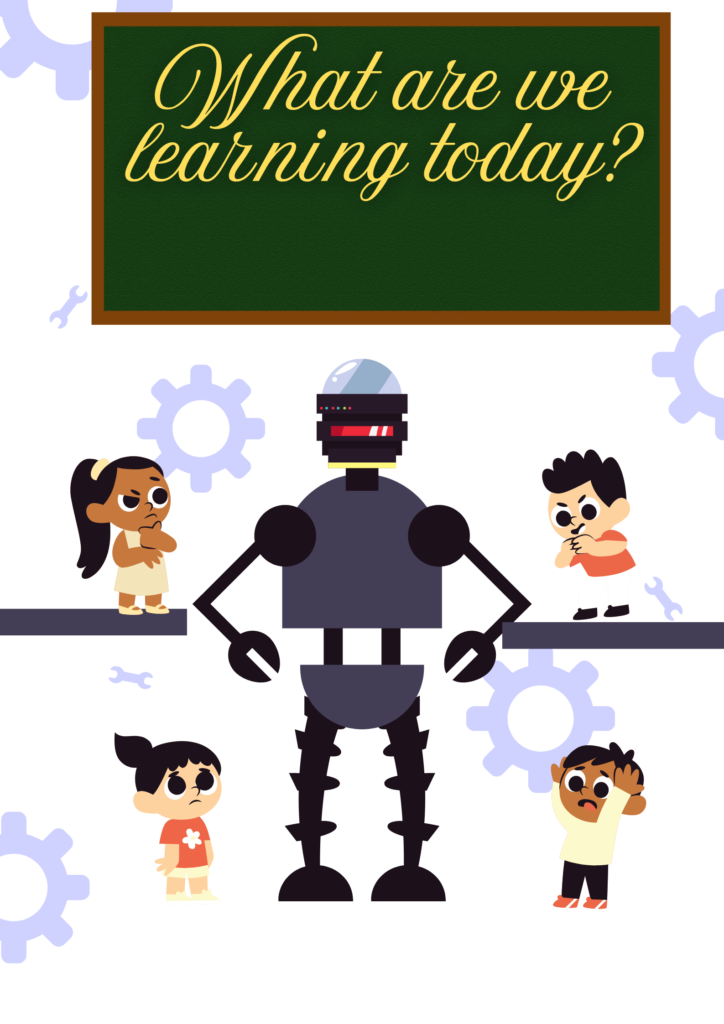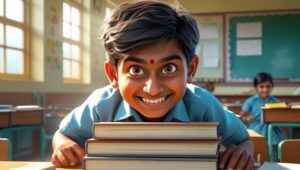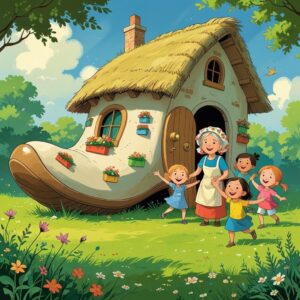

Summary
Set in a futuristic world of 2157, ‘The Fun They Had’ explores the theme of the advancement of technology and its impact. The story centers around two children Margie, aged 11, and Tommy, aged 13, living in a world where technology has eliminated communal schools and human teachers.
In the beginning, Tommy discovers a rare printed book from the attic in their home. It was an old dusty book with yellowed, wrinkled pages with letters fixed to their position, unlike their television screen with millions of books and moving letters. Margie had previously heard about printed books from their grandfather, but it was her first time seeing one.
The book introduced them to traditional schools where children studied together in a physical building with a human instructor or teacher, which fascinated Margie with the idea of a conventional school different from her fully automated yet monotonous virtual school. She feels isolated imagining what fun the children had in the century-old school. Their instructor is an advanced robot, a mechanical device specially configured to their pace and needs, yet Margie is dissatisfied with her school and imagines how entertaining the old schools must have been.
Even though advanced schooling provides efficiency and personalization, it chips away from the human experience of social and emotional aspects of learning. The story ends with little Margie reluctantly returning to her studies while daydreaming about a past she can never return to.
Analysis
Asimov boldly predicted the transformative impact of computers and technologies in 1951, setting his short story in a futuristic 2157, describing how the world has changed. Mechanical devices have replaced institutional schools and teachers. Advanced, efficient technology caters to the needs of learners. Even books are no longer printed on paper but rather shown on screen.
Margie, the narrator of our story, however, despises her school. She finds her lessons monotonous and boring. The rare book gave her a glimpse of the past traditional school, and she started to idealize the concept of human teachers, school buildings, and fellow students, daydreaming about the children having fun, cleverly instigating us to probe the purpose of schooling and education. Virtual classrooms strip away the social and emotional aspects of education. She feels confined and isolated from her peers. Her longing reflects a universal desire for communication, proving technology, while progressive, can dehumanize human experiences.
The title suggests the ironical human nature of romanticizing the past. Tommy and Margie envision the old schools through the dusty old book, reflecting our nostalgic nature of looking at the past with rose-colored glasses. Traditional schools, while idealized, are not without shortcomings, and it was not always fun, as suggested by the title. Asimov subtly compares the old and the new. He did not overly critique the technology but warned us of our overindulgence of it.
Answer the following questions
1. How old are Margie and Tommy?
In the short story Margie, our protagonist is 11 years old and her friend Tommy is 13 years old.
2. What did Margie write in her diary?
Margie wrote in her diary about a rare book Tommy found in the attic.
3. Had Margie ever seen a book before?
No, Margie had never seen a book before. She lives in futuristic 2157 when physical books are no longer printed and have been replaced by telebooks.
4. What things about the book did she find strange?
Margie finds traditional communal schools strange. She lives in 2157 when school is a room inside the house, not a separate building. She is taught by robots instead of humans. She finds the usage of physical books strange as she has been taught with Telebooks since childhood. She finds the concept of attending school and classes with her peers and being taught by a human strange.
5. What do you think a telebook is?
In the context of Issac Asimov’s short story The Fun They Had, Telebook refers to a digital or electronic book displayed on a computer or television screen.
6. Where was Margie’s school? Did she have any classmates?
Margie lives in 2157. Her School is a room beside her bedroom. She did not have any classmates.
7. What subjects did Margie and Tommy learn?
Margie and Tommy’s education was highly individualized and automated. The mechanical teacher was configured to teach according to the child’s pace and needs and seemed to cover a curriculum similar to traditional school- Arithmetic, Geography, History, and language skills.
II. Answer the following with reference to the story.
1. “I wouldn’t throw it away.”
(i) Who says these words?
Tommy.
(ii) What does ‘it’ refer to?
It refers to the dusty, wrinkled, century-old book he found in the attic.
(iii) What is it being compared with by the speaker?
The old traditional paper book is beings compared to a Telebook.
2. “Sure they had a teacher, but it wasn’t a regular teacher. It was a man.”
(i) Who does ‘they’ refer to?
They refer to children who went to traditional schools, mentioned in the century-old book.
(ii) What does ‘regular’ mean here?
Regular means normal in this case a human teacher.
(iii) What is it contrasted with?
The human teacher is being compared to a robotic teacher.
III. Answer each of these questions in a short paragraph (about 30 words).
1. What kind of teachers did Margie and Tommy have?
Margie and Tommy had a big black robotic teacher. It was customized to teach according to the Child’s pace and needs. It is described as a big black-box-like device with a screen, a slot for inserting homework, and a mechanical voice for delivering lessons.
2. Why did Margie’s mother send for the County Inspector?
Margie, our protagonist, lives in 2157 and is instructed by an automated big black box-like device, a robot. It kept giving her more and more advanced geography papers to solve. Suspecting that something was wrong with the device, her mother sent for the County Inspector to inspect the machine.
3. What did he do?
The County Inspector gave Margie an apple and disassembled the robot to inspect malfunctions. He assured Margie’s mother of her satisfactory progress in her studies and clarified that the geography sector of the device was geared a bit too advanced for an average 10-year-old. He slowed down the pace at which the Geography sector Operated, adjusting it to Margie’s learning ability.
4. Why was Margie doing badly in geography?
The robot was malfunctioning and giving her advanced geography papers to solve, which resulted in Margie’s consecutive poor performance.
a) What did the County Inspector Do to help her?
The County Inspector adjusted the robot’s Geography sector to fit Margie’s learning ability and assured her mother of her satisfactory progress. He also gave her an apple and patted her head.
5. What had once happened to Tommy’s teacher?
Tommy’s robot malfunctioned once. The Geography sector blanked out completely. It took almost a month to repair the device.
6. Did Margie have regular days and hours for school? If so, why?
Yes, Margie had regular hours of school. The story mentions that the mechanical teacher was there at the same time every day except Saturday and Sunday. Margie’s mother believed that little girls learn better if they learn at regular hours.
7. How does Tommy describe the old kind of school?
Tommy envisions traditional schools through the dusty pages of the old book. The book describes how human teachers taught students of the same age group in a shared classroom.
8. How does he describe the old kind of teachers?
Old kinds of teachers are the human teachers from the 20th century in Issac Asimov’s The Fun They Had. They are real people and not machines. They taught groups of students together in a physical building.
IV. Answer each of these questions in two or three paragraphs (100 –150 words).
1. What are the main features of the mechanical teachers and the school rooms that Margie and Tommy have in the story?
Margie and Tommy live in the futuristic world of 2157 in the context of Asimov’s short story The Fun They Had, a world where education is highly individualistic and automated.
Advanced technology has eliminated traditional schools and teachers. Printed books are considered a waste and no longer printed. Telebooks or digital books displayed on a screen are in use. Their instructor is a big black box-like robot with a screen for showing information, a mechanical voice for imparting lessons, and a slot for inserting homework and test papers written in punch code. Robots are customized to teach according to the child’s learning ability and pace. They study in a room inside their home at a fixed time every day of the week except Saturday and Sunday. Their curriculum seemed to mirror traditional school and taught History, Geography, Arithmetic, and language skills.
2. Why did Margie hate school? Why did she think the old kind of school must have been fun?
Margie, the narrator of our story, despises her school. She finds her lessons monotonous and boring. The rare book gave her a glimpse of the past traditional school, and she started to idealize the concept of human teachers, school buildings, and fellow students, daydreaming about the children having fun, cleverly instigating us to probe the purpose of schooling and education.
Virtual classrooms strip away the social and emotional aspects of education. She feels confined and isolated from her peers. Her longing reflects a universal desire for communication, proving technology, while progressive, can dehumanize human experiences. The title suggests the ironical human nature of romanticizing the past. Tommy and Margie envision the old schools through the dusty old book, reflecting our nostalgic nature of looking at the past with rose-colored glasses.





